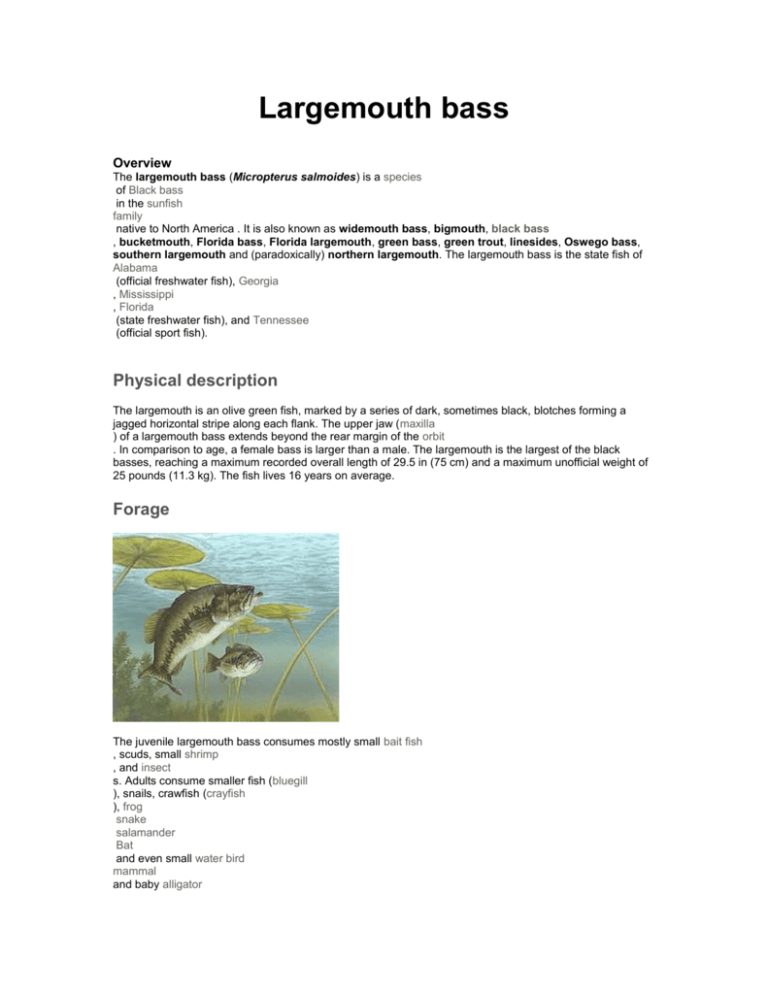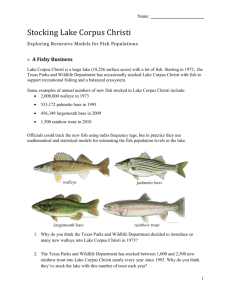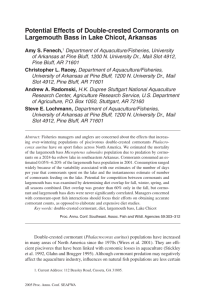
Largemouth bass
Overview
The largemouth bass (Micropterus salmoides) is a species
of Black bass
in the sunfish
family
native to North America . It is also known as widemouth bass, bigmouth, black bass
, bucketmouth, Florida bass, Florida largemouth, green bass, green trout, linesides, Oswego bass,
southern largemouth and (paradoxically) northern largemouth. The largemouth bass is the state fish of
Alabama
(official freshwater fish), Georgia
, Mississippi
, Florida
(state freshwater fish), and Tennessee
(official sport fish).
Physical description
The largemouth is an olive green fish, marked by a series of dark, sometimes black, blotches forming a
jagged horizontal stripe along each flank. The upper jaw (maxilla
) of a largemouth bass extends beyond the rear margin of the orbit
. In comparison to age, a female bass is larger than a male. The largemouth is the largest of the black
basses, reaching a maximum recorded overall length of 29.5 in (75 cm) and a maximum unofficial weight of
25 pounds (11.3 kg). The fish lives 16 years on average.
Forage
The juvenile largemouth bass consumes mostly small bait fish
, scuds, small shrimp
, and insect
s. Adults consume smaller fish (bluegill
), snails, crawfish (crayfish
), frog
snake
salamander
Bat
and even small water bird
mammal
and baby alligator
s. In larger lakes and reservoirs, adult bass occupy deeper water than younger fish, and shift to a diet
consisting almost entirely of smaller fish like shad
, trout
, ciscoes
, shiners
, and sunfish
. Prey items can be as large as 25 to 35% of the bass's body length. Studies of prey utilization by
largemouths show that in weedy waters, bass grow more slowly due to difficulty in acquiring prey. Less
weed cover allows bass to more easily find and catch prey, but this consists of more open-water baitfish.
Paradoxically, with little or no cover, bass can devastate the prey population and starve or get stunted.
Fisheries managers must consider these factors when designing regulations for specific bodies of water.
Under overhead cover, such as overhanging banks, brush, or submerged structure, such as weedbeds,
points, humps, ridges, and drop-offs, the largemouth bass will use its senses of hearing, sight, vibration, and
smell to attack and seize its prey. It can sometimes hold up to five sunfish in its mouth. Adult largemouth are
generally apex predator
within their habitat, but they are preyed upon by many animals while young.
Spawning
In the spring, When the Water Temperatures reaches 60F, Largemouth Bass that are ready to breed move
into Spawning Grounds in Backwaters, Channels flats and shallow protected areas. The Male will spend a
few days selecting a nesting site in 1 to 4 Feet of water; once a site has been selected he will prep the Nest
by using his body and tail. When the water reaches 64F to 68F, spawning will begin. Female Largemouths
will lay their eggs, then return to deeper waters and will not eat for a few weeks. The Male Largemouth will
stay and protect the nest. As long as the Water Temperatures holds at 68F to 72F, the eggs will hatch in 2 to
6 days. The Male Largemouth will protect the fry until they reach an Inch in length.
Angling
Largemouth are keenly sought after by angler
and are noted for the excitement of their fight. The fish will often become airborne in their effort to throw the
hook, but many say that their cousin species, the smallmouth bass
, can beat them pound for pound. Anglers most often fish for largemouth bass with lure
such as plastic worm
(and other plastic baits), jigs
, crankbaits and spinnerbait
s. A recent trend is the use of large swimbait
to target trophy bass that often forage on juvenile rainbow trout
in California
. Live bait, such as nightcrawlers
, minnows
, frogs, or crawfish can also be productive. In fact, large golden shiner
are one of the best things to use to catch trophy bass, especially when they are sluggish in the heat of
summer time or in the cold of winter. Largemouth bass are known to take any bait they consider alive.
There is a strong cultural pressure among largemouth bass anglers which encourages the fish's live release,
especially the larger specimens. Largemouth bass, if handled with care, respond well to catch and release
; many studies have shown specimens which have survived being hooked and released multiple times.
The Largemouth Bass has been known to exist in many of the lower 48 states of the U.S. Although it is most
popular in the southeastern states, many different varieties of the largemouth bass can be found in the north
and western regions. They are an invasive species in the Canadian province of New Brunswick, bringing in
sea lice and eating native fish.
Invasive species
The Largemouth bass has been introduced into many other countries due to its popularity as a sports fish
with tasty flesh. It causes the decline, displacement or extinctions of species in its new habitat, for example
in Namibia
.
The text of this article is licensed under the GFDL.
AbsoluteAstronomy.com © 2011. All Rights Reserved.









